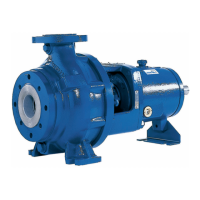KWP
3.1.2 Shaft seal
The shaft is sealed at its exit through the casings by soft packed
stuffing boxes or by mechanical seals. Mechanical seals can
be fitted in lieu of soft packing (or viceversa) at any time during
the service life of the pump with a minimum of machining of
the stuffing box housing. Regarding machining details refer to
the pump manufacturer.
3.1.2.1 Stuffing box
Soft packed stuffing boxes reduce the flow of leakage liquid at
the clearing gap between casing and shaft protection sleeve
when the pressure inside the pump is higher than atmospheric.
Conversely, on pumps which operate on suction lift, the soft-
packed stuffing box prevents the ingress of air into the pump.
Sealing is effected by means of soft packing arranged in a
number of rings in the annular space between the stuffing box
housing (151) and the shaft protection sleeve (524) and lightly
compressed by the stuffing box gland (452)
3.1.2.2 Packing the stuffing box
The stuffing box will only be able to perform its vital function
satisfactorily on condition that it is carefully packed and
properly maintained as prescribed.
Before packing, thoroughly clean stuffing box gland (452),
packing compartment and shaft protection sleeve (524)
To cut the packing rings to correct length, use a suitable
wooden cutting jig (we can supply same on request), to ensure
that the packing rings are of the correct length and that their
ringbutts come into correct contact with one another (See Fig.
7)
Fig. no. 7 : Cutting the packing rings to length
If the packing rings are either too long or too short, the stuffing
box will not be able to perform its function properly. In the
case of asbestos-graphite packing material, the rubbing faces
of the individual rings should be lightly coated with
molybdenum disulphide before insertion in the packing
compartment. The first ring is then inserted and pushed home
into the compartment with the aid of the stuffing box gland.
The following packing rings are then inserted into the packing
compartment one by one, making sure that the butt joint of
each ring is offset 90 approx. in relation to the butt joint of the
preceding ring; the individual rings are pushed home into the
packing compartment with the aid of the stuffing box gland.
The packing rings should only be pressed lightly against one
another. They should be inserted in the packing compartment
in such a way that the a clear gap of 6 to 8 mm is left at the
outer end of the compartment for the positive guidance of the
stuffing pressure ring.
The inserted packing rings should then be compressed
moderately with the aid of the stuffing box gland (452) and of
the nuts. Then the nuts should be slackened again by one to
two complete turns, and thereafter tightened lightly by hand.
The correct and even seating of the stuffing box gland (452)
should be checked when the pump is subjected to suction
pressure, by inserting a feeler gauge between the gland (452)
and the shaft protection sleeve. (524)
In the case of the special stuffing boxes, a lantern ring is also
inserted in the packing compartment, viz, at the centre of the
compartment (between the packing rings). In these cases, an
information plate is affixed to the stuffing box housing, showing
the position of the lantern ring. The ring must register beneath
the drilled hole in the stuffing box housing, to enable the sealing
or flushing liquid to flow through the hole and the ring. The
sealing or flushing liquid pressure should be 1 to 4 bar above
the pressure reigning in the packing compartment of the
stuffing box.
The packing of the stuffing boxes should be carried out with
great care, to avoid an excessively high radial pressing force
of the packing rings against the shaft protection sleeve, which
might damage the latter. If the shaft protection sleeve is scored
or grooved, even a new packing can not be expected to last
very long in service.
A newly packed stuffing box should leak profusely at first. If
this leakage does not cease of its own accord after a relatively
short period of operation, the nuts on the gland should be
tightened slowly and evenly while the pump is running, until
the stuffing box only drips slightly. Make sure the stuffing box
glands (452) are tightened evenly and not askew, as otherwise
the shaft protection sleeves (524) might be damaged.
If the newly packed stuffing boxes start to smoke when the
pump is started up for the first time, the pump should be
switched off. If the smoking persists after the pump has been
started up again and operated several times in succession,
the nuts on the gland should be slackened slightly, or the
stuffing box should be inspected if necessary.
3.1.2.3 Packing material
When selecting the packing material, make sure it is
compatible with the fluid pumped (consult the manufacturer
in case of doubt)
Packing material which has been kept in store for a certain
period has a longer service life than packing material fresh
from the packing manufacturer.
Significance of the numbers punched on this instruction plate
is as follows
In this case 3
The no. of packing rings punched for the different packing
arrangements are as follows
3.1.2.4 Dimensions of the packing compartment
Fig. no. 8 : Stuffing box compartment
3

